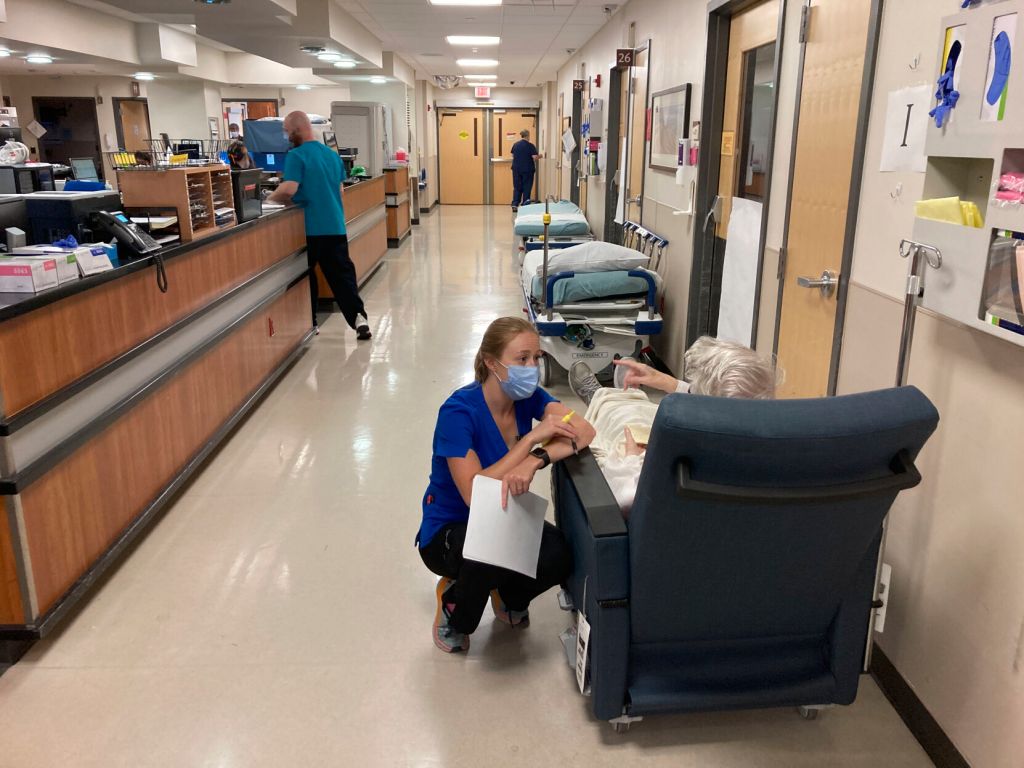Nurse shortage in Oregon impairing health care, advocates say
Published 11:00 am Monday, November 22, 2021

- A nurse talks to a patient in the emergency room at Salem Hospital on Aug. 20, 2021, in Salem with gurneys lining the hallway behind them, ready to take patients if needed. {div id=”highlighter--hover-tools” style=”display: none;”} {/div}
SALEM — The workforce shortage among the state’s health care workers has become so dire that it is starting to affect the quality of care, advocates said recently.
Testifying on Tuesday, Nov. 16, during an informational meeting of the House Interim Committee on Health Care, Matt Calzia, a registered nurse and consultant with the Oregon Nurses Association, detailed what it’s like on the front lines.
In September, he helped out in an intensive care unit. What he experienced was unlike anything he’d seen before, he said.
Normally during an infectious disease wave, like the flu season, six to eight patients in the ICU would be extremely ill.
In his unit, there were 40.
“I would categorize that as a mass casualty event,” Calzia testified. “Never have we seen one diagnosis fill up the entire ICU.”
The patient load is having a deep effect on nurses and their well-being, prompting an exodus of nurses leaving their jobs or seeking reduced hours, Calzia said. The association represents 3,000 nurses.
The loss is affecting patients, he said.
“What we see from this is our care standards start to deteriorate,” Calzia said. “That has a huge impact on patients.”
Some are remaining longer in intensive care than they would in the past, he said. That’s in part due to the severity of the disease but he indicated that it’s also caused by employees not having as much time to tend to patients as they did before.
The goal of nurses is to “progress” patients off of life support, Calzia said. That involves decreasing the medication or lowering the amount of oxygen a patient is receiving.
“The nurses don’t have time to progress the patients so they stay on ventilators longer,” Calzia said. “The recovery takes longer. We have to put them on their bellies and give them medication to paralyze them and then they’re getting wounds on their faces. It’s just this compounding problem.”
The longer a patient remains on a ventilator, the worse off they’re likely to be, Calzia said.
“We know that every day on life support makes the recovery longer,” he said.
With overloaded staff, the usual checks and balances in the health care system are failing. Cohesive, compassionate care is harder to achieve when workers are stretched. He recounted one incident to make his point.
A patient had a special intravenous line, known as a PICC line, that connects to the central veins near the heart and is generally used for medication or liquid nutrition. Cleaning it involves a sterile process and “is a big deal,” Calzia said.
One nurse changed the patient’s IV dressing, he said. Then soon after, another staff member told the patient they were going to remove the line.
The patient asked why since the dressing was just changed, Calzia said.
“I felt the distress in that patient’s eyes,” Calzia said. “We’re no longer patient-centered.”
Calzia’s account resonated with one Health Care Committee member, Rep. Suzanne Weber, R-Tillamook. Weber said she was recently in the hospital and had an intravenous line delivering pain medication. At one point, a nurse came in and removed it.
“There wasn’t anything wrong with it,” Weber said.
The shortage of nurses, certified nursing assistants and others is not only affecting hospitals, experts told the committee. It is also affecting long-term care facilities.
“The last couple of years have been devastating for our sector,” said Libby Batlan, a spokewoman for the Oregon Health Care Association, which represents long-term care companies.
“Some (facilities) in rural parts of the state are in danger of closing.”
Batlan said providers have tried to retain staff with a variety of incentives, including hazard pay, health care insurance and reducing paperwork. They’ve also turned to temporary staffing agencies — as have hospitals. That’s meant higher operating costs, with agencies raising rates by as much as 30%, Batlan said.
Several witnesses said Oregon needs to encourage more people to choose health care as a profession.
Patsy Richards, director of Long-Term CareWorks, a nonprofit that trains certified nursing assistants and others, said children need to be introduced to role models when they’re young. She remembers a physician giving presentations to her kindergarten class, but not any other health professionals.
The state could help by providing tuition forgiveness to nurses who agreed to work in rural areas after graduation, said Marty Carty, government affairs director for the Oregon Primary Care Association, which represents community health centers. Currently, a rural health care program offers loan forgiveness to medical, physician assistant, nurse practitioner, dental and pharmacy students.
Carty also said students and graduates need more child care.
“Financial supports and incentives are critical if we are going to move forward in enticing and increasing access for folks to join the health care workforce,” Carty said.
Resolving the crisis, though, will take time, according to Michael Cox, vice president of public affairs and communications at the Oregon Association of Hospitals and Health Systems. In a statement to the Capital Chronicle, he said it could take years for the health care system to recover from the pandemic.
“We need the entire health care community to partner with policymakers to solve this crisis to ensure we can continue to provide the best patient care possible and care for our communities,” Cox wrote. “With a variety of solutions and working together, we can forge a path that will take us from the current state to a future workforce that matches the needs of our communities.”





